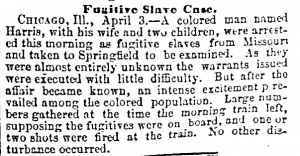Published almost fifty years ago, Stanley Campbell’s The Slave Catchers (1970) has shaped much of our understanding about the fugitive slave crisis. Campbell’s work takes a close look at the enforcement of the controversial Fugitive Slave Law of 1850, part of the Compromise of 1850. The law was designed to make it easier for Southern slaveholders to reclaim runaway slaves, and empowered federal commissioners to seize alleged fugitives, hold a “summary” hearing and then return them to slavery. In the book, Campbell argues that despite its unpopularity throughout much of the North, the law was faithfully and emphatically enforced. Two statistics that stand out in Campbell’s research are the 332 fugitive slave cases he documents between 1850-1860, and the figure that 82.2 percent of alleged fugitives captured and brought before commissioners were returned to slavery.
In terms of this project, however, Campbell’s book is notable for the omission of the term “slave stampedes.” While he covers several cases that might be considered to meet the criteria of a slave stampede, Campbell does not address it as a broader concept or theme. In describing the 1847 escape of more than a dozen enslaved people from Maryland, Campbell simply records that they “fled their masters and escaped into Pennsylvania,” devoting more attention to the subsequent trial of abolitionist Daniel Kaufman, who was accused of harboring them. He comes closest to using the term in his description of the controversial Margaret Garner case (where eight Kentucky slaves escaped into Ohio), referring to the group as a “slave party.” Fortunately for scholars, Campbell includes an invaluable appendix, documenting all 332 fugitive slave cases his research uncovered. A cursory glance reveals evidence of at least 10 mass escapes or potential slave stampedes between 1850-1860, though most went unmentioned in the main body of text. [1]
For the purposes of this project, it is also worth noting that much of Campbell’s research focuses on the eastern seaboard, primarily in Philadelphia, New York and Boston. His coverage of the midwestern states is noticeably less thorough, though he does describe one important group escape from Missouri in April 1861. Four freedom seekers–a man named Onesimus Harris, his wife and two children–escaped from St. Louis County, and journeyed as far north as Chicago before being captured. The family was then taken to Lincoln’s own Springfield, less than two weeks before the first shots of the Civil War were fired. In Springfield, they appeared before U.S. Commissioner Stephen A. Corneau, who declared the family to be slaves and remanded them back to bondage in Missouri. [2] When the Chicago Tribune first reported on this episode in early 1861, the anti-slavery newspaper claimed that the arrest (under a Republican administration) was producing “a general stampede” of black residents from the city. The text of the article (which Campbell does not cite or quote), reads: “There was immediately a general stampede of fugitive slaves harbored and residing in this city and within a day or two hundreds of them will have left for Canada.” [3] While Campbell’s work remains a milestone in the historical understanding of the law and its enforcement, this project aims to place new emphasis on slave stampedes that have too often been overlooked.
[1] Stanley Campbell, The Slave Catchers: Enforcement of the Fugitive Slave Law, 1850-1860 (Chapel Hill: University of North Carolina Press, 1970), 12-13, 123-124, 144, 199-207.
[2] Campbell, The Slave Catchers, 188; Chicago Post, quoted in “Great Negro Excitement!,” The Liberator, April 26, 1861.
[3] Chicago Tribune, “Onesimus and His Family Sent Back,” April 4, 1861 [Newspapers.com]


